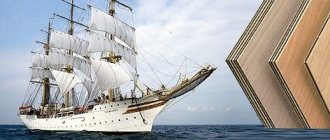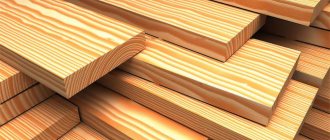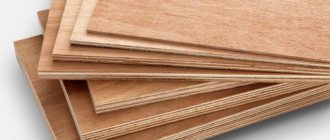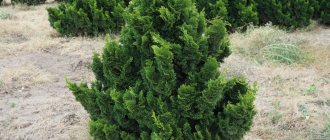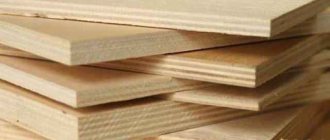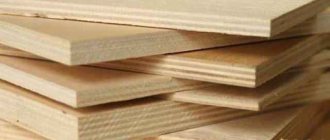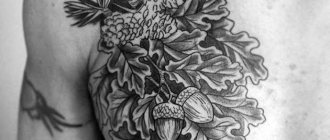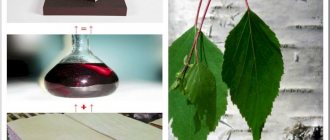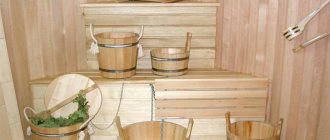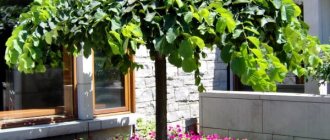Any of us has encountered construction work, and many understand how important it is to approach the choice of building material as responsibly as possible, taking into account all the nuances.
This article will discuss the choice of plywood - one of the popular building materials. Plywood is a sought-after material, which attracts not only the eyes of builders, but those who want to make something for themselves, the so-called “handmade lovers.”
Everyone may face the problem of choosing it. Like many other building materials, plywood must meet relevant product quality requirements.
Plywood is a tree, so it is unacceptable to produce it from non-environmentally friendly products. The presence of formaldehyde in it indicates a lack of proper quality and a violation of production requirements.
Types of plywood
Various types of plywood are produced; it can be either moisture-resistant or laminated. Its scope of application can be very diverse.
Plywood is made from different types of wood; it can be made from one type of wood or from several types. This is determined by the outer layer of plywood, the central layers are not considered.
Plywood is:
- Plywood made from birch or larch plywood.
- Plywood made from pine needles
- Plywood made from several types of wood
Birch plywood
Larch plywood is made from birch veneer; due to its structure, plywood made from birch shavings is much stronger, it can withstand a load of 650 kg per m3.
This is 20% more durable than plywood made from other types of wood.
- Plywood made from birch veneer is much more expensive than other types.
- This is due to the fact that to create such plywood, more components are required to compensate for the lack of resin in the wood.
- Only by compensating for their deficiency can you get good plywood.
Plywood made from birch is popular. And they are used in the construction of houses. And also as containers for transporting goods. Birch plywood is also used for the construction of cars.
Softwood plywood
Coniferous plywood is the most budget option compared to birch plywood. To make coniferous plywood, spruce and pine bark is used, making it lighter.
Using bark to create coniferous plywood allows you to achieve an interesting pattern on its surface.
- The bark contains natural resin, which does not allow the finished product to be subject to rotting and various weather conditions.
- In terms of strength, it is clearly inferior to birch leaf.
- Such plywood is used in the design of premises, using them to create various interior elements or design structures.
It is impossible to definitively answer which plywood is better to choose; they have different qualities. Birch plywood is a very durable softwood that is less susceptible to weather conditions. The use of each type of plywood is purely individual. It all depends on the place and scope of application of the plywood sheets.
Parameters for pressing plywood boards
Plywood pressing lines are configured according to the following parameters:
- The temperature of the slabs, depending on the brand of glue and the layer layer of the sheets.
Advice! For phenolic adhesive compositions, the temperature should be 10-20 degrees higher than for urea adhesives. The thicker the sheet, the lower the gluing temperature should be.
- The number of sheets placed in the press space depends on the thickness of the plywood.
- Humidity – from 8 to 12%.
- Working pressure depends on the design of the elements that are involved in its transmission, as well as the brand of product. If we are talking about hard hot plates, then the working pressure depends on the type of plywood: General purpose - from 1.8 to 2.2 MPa.
- Decorative – 3.0 MPa.
- Bakelized - from 3.5 to 4.5 MPa.
- Chipboard – 15 MPa.
Plywood under pressure.
The plywood gluing cycle consists of several stages. At first glance, this instruction may seem simple, but it requires precise adjustment of the equipment:
- The packages are loaded into the press.
- The press plates rise and close.
- Working pressure is created.
- The panels are kept under pressure for a certain time. This time period depends on the type of wood, brand of glue, thickness of the package and ply, as well as the temperature of the press plates.
- Reduced pressure. Consists of two stages:
- Rapid decrease in pressure from maximum to moderate.
- Slow release, which is used to avoid intense steam formation that can lead to destruction of plywood sheets.
- The slabs are opened, after which the plywood sheets are unloaded.
- After the material is unloaded from the hot press, the sheets must undergo cooling. This is necessary in order to reduce humidity (if protein adhesive mixtures are used) or reduce the level of formaldehyde emission (if urea-formaldehyde adhesives are used).
- The circular saw cuts the edges necessary to align the sheets.
Processing of plywood sheets after pressing
Advice! If an unacceptable defect is found on the sheet, it is necessary to re-cut the plywood to a smaller size specified in the standard.
- If you need large-format sheets of plywood for your work, they can be obtained by gluing smaller parts together:
- If we are talking about thin material, then gluing is carried out “on the mustache”.
- For thick sheets, gluing occurs “tooth type”.
- The material is sorted relative to the veneer species of the outer layers, by thickness, formats, grades and brands. Based on sorting, the material is divided into export and intended for general use.
Inspection of material for defects.
- Selective grinding, which is carried out at the request of the customer.
- Packaging produced manually or using automated lines.
Plywood made from several types of wood
Plywood sheets are also made by combining pine and birch shavings. It combines the qualities of two different plywoods.
The combined plywood sheet is durable and resists moisture and various temperature changes well. It is used for the construction of furniture and for renovation of buildings.
Plywood as a universal building material
The minimum number of veneer sheets in plywood is 3. The veneer layers are arranged so that the fibers in adjacent rows are perpendicular. This method of placing glued sawdust guarantees not only a certain stability of shape, but also the necessary strength.
The latter is achieved through the use of new technologies, which include:
- lamination;
- veneering with planed material;
- coloring;
- varnish coating.
Plywood weighs much less than real wood. Its prostate processing puts it on par with other modern materials. At the same time, it has high thermal conductivity qualities. Also, most of its species are certified regarding environmental safety.
Manufacturers produce several types and types of plywood. And each in its marking has a designation regarding where the most successful use of this material will be.
A few words about what types of plywood are:
Types of plywood by type of adhesive
Wood veneer is fastened together by mixing it with an adhesive. Plywood is divided into types depending on the composition for gluing veneer.
- FBA plywood. An albumin-casein composition is used to glue veneer and layers together. This type of plywood is considered safe and can be used for the construction of children's furniture and toys. FBA plywood is not waterproof, it can be used in the construction of rooms with low humidity levels.
- FC plywood. A urea compound is used to glue the components together. It is also considered safe and suitable for arranging children's and residential premises. Not waterproof.
- FKM plywood. Melamine composition is used to glue the components together. Can be used in rooms with low humidity. The composition is not completely environmentally friendly.
- FSF plywood. It is moisture resistant plywood. The composition that is used for gluing the components, phenol-formaldehyde, contains harmful substances. This type of plywood is not recommended for use in residential construction and furniture, as it emits harmful substances.
Bakelite plywood. To create it, a bakelite composition is used. It can withstand various weather conditions. Resistant to microorganisms and withstands various temperatures.
Does not disintegrate when exposed to sea water. This plywood sheet is also divided into several types, depending on the gluing method.
- FBS plywood. Each layer of plywood is impregnated with bakelite glue. This plywood is one of the highest quality plywood sheets.
- FBS1 plywood. This type of plywood is inferior in quality. To create it, the layer is coated with an adhesive composition.
- FBS1A plywood. When creating this type of plywood, only the longitudinal layers are coated with alcohol-soluble glue, due to this it is applied to plywood with the lowest quality indicator.
Sheet sizes
The dimensions of the slabs are determined in accordance with the standards specified in GOST. It is possible to manufacture products in other formats, but only if the required parameters are met.
The division of plywood by size is arbitrary and depends more on the availability of appropriate equipment from the manufacturer; in addition, when ordering a large batch of material, plywood can be cut to the customer’s size
The most popular sizes are:
- FC sheets are most often produced with dimensions of 1515 x 1525 mm and thicknesses of 3, 4, 8, 10, 12, 15 and 20 mm. Such products are small-format and are excellent for indoor work.
- FSF slabs are in demand in different sizes: length – 2400 and 3000 mm, width – 1220 and 1500 mm, thickness – 9, 12, 15, 18, 21 and 24 mm. Large dimensions provide the ability to quickly finish the building outside.
Since FSF sheets are the most in demand, the size range of this material is the widest
- FBS products have dimensions of 1525 x 1525 mm and thicknesses of 10, 12, 15, 18, 20, 21, 25, 27 and 30 mm. The material is quite durable and can withstand even severe mechanical stress.
- FBV has dimensions of 1220 x 2440 mm, thickness - 7, 10, 12, 15, 18 and 21 mm.
To produce high-quality moisture-resistant plywood, only birch veneer is used. The degree of sanding can also affect the parameters of resistance to moisture: complete processing eliminates the presence of fine pile, which absorbs excess liquid most quickly.
Attention! Bakelized plywood has the largest dimensions; the length of the panels can reach 5.7 and 7.7 m. This format is excellent for finishing without numerous seams.
Moisture-resistant sheets with bakelite impregnation are expensive, so when purchasing it is useful to know the general transportation parameters of the material
Surface treatment type
Plywood is also classified according to the type of processing of the outer layer of the plywood sheet. Happens:
- Laminated plywood. It is created by covering the sheet with waterproof compounds, most often varnishes.
- Sanded plywood on one side.
- Sanded plywood on both sides.
- Not polished.
Elementary task
Laying plywood allows you to level the surface and protect it from corrosion. But it is not necessary to follow the tradition of creating a subfloor. You can significantly reduce the cost and still achieve good results.
It is recommended to cut the sheets using an electric jigsaw - it fits perfectly and does not damage their structure. It is necessary to create a screed or tidy up the existing one, attach the sheets in the required sequence.
Laying plywood on a concrete floor involves gluing it. Two-component or water-based glue is suitable. Plywood is attached to a wooden floor using self-tapping screws. This may ruin the appearance.
Painting a darker color instead of stain will hide the caps. However, it is easy to accidentally get caught in them. It is not safe. It is better to put a second layer on top, gluing the sheets. KS glue, for example, is suitable for these purposes.
The disadvantage of ordinary, most inexpensive plywood sheets is their susceptibility to moisture and possible surface unevenness - the presence of knots and bulges.
Before proceeding with installation, each sheet should be treated with putty with polyvinyl acetate, soaked first on one side, then on the other, and allowed to dry. After this, treat it with an antiseptic and begin attaching it to the screed. When the work is completed, you need to sand the surface, cover it with stain and varnish.
Scope of application of plywood
Plywood can be used not only in construction, but also in various fields. Its different structure allows this.
- Marine plywood. It is made only from quality materials. Plywood should perfectly withstand the effects of sea water and microorganisms.
- For the construction of furniture. The plywood should be safe and strong, and should be slightly moisture resistant.
- Construction. Birch plywood sheets are used for this purpose, as they are durable. It is used for finishing walls, ceilings and floors.
- Aviation. For such needs, FSF plywood is used.
- Decorative. It is used as a basis to create a flat surface. Type of plywood FB.
- Cars. Plywood is used to cover the body of trucks.
There is a wide range of plywood sheets on the shelves of construction stores. Having studied the characteristics and scope of each of them. You can easily select the one you need.
Criteria to pay attention to when choosing
If you don’t know which option to use for certain jobs, then you just need to analyze all the criteria that the optimal option in your case should meet:
| Strength | This indicator is important if plywood is used to construct structures that will carry a certain load-bearing load. This applies to formwork for pouring concrete, interfloor decks and subfloors, as well as roof sheathing. It is best to consult with specialists; most often they can give all the necessary information and save you from studying the indicators of different options |
| Moisture resistance | A very important nuance on which both the price of products and their technical characteristics directly depend. For outdoor work, moisture-resistant products are required. While for interior decoration this indicator is not so important, because the premises are maintained at a certain temperature and humidity |
| Environmental friendliness | This criterion must be taken into account, since there are options on sale with a high content of formaldehyde, which cannot be used for interior work. Therefore, it is important to check the material for its emission class; we will consider this indicator in more detail below. |
| Appearance | The way plywood looks is of great importance if it is used for cladding walls, ceilings and other types of final surface finishing. This indicator is influenced by grade, so you should decide in advance whether the appearance of the sheets is important to you |
Advice! Never purchase plywood with a moisture content of more than 15%, as it will begin to warp and crack once it is secured. Buy products only from sellers who have well-equipped warehouses.
If you need to make semicircular products, then choose an option with increased flexibility
